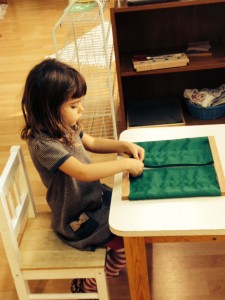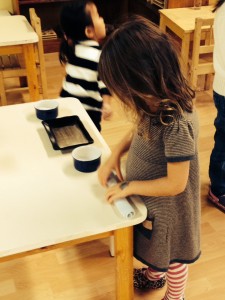A child who becomes a master of his acts through long and repeated exercises (of practical life), and who has been encouraged by the pleasant and interesting activities in which he has been engaged, is a child filled with health and joy and remarkable for his calmness and discipline – Maria Montessori
In our Introduction to Practical Life, we discussed the direct and indirect purposes of our Practical Life exercises in our classrooms. When visiting our classrooms, take the time to notice our specific Practical Life activities and you will see why we call our classrooms “Prepared Environments.” Teachers carefully select every single material found on our shelves.
Keep your eyes open for some of the following characteristics:

Familiar: They resemble mundane activities that children see regularly in their family life and the objects are therefore familiar. This element of familiarity assists the children for orientation to their new classroom. Objects also reflect the local cultural and social environment helping children increase their independence, adaptation and ability to contribute to their newfound social community.
Child-sized: Materials are meant to fit small hands. We take into consideration, the child’s proportions in order to encourage precision and the child’s confidence in his/her coordination. Well-proportioned tools that are heavy enough to provide a tactile feedback facilitate the child to fine tune with his/her motor skills.
Real, functional and complete: Objects are recognizable and have a realistic appearance that is connected to their purpose. Materials and activities must be efficient to build self-confidence. By providing children with real and functional tools, we show them that their work is valued. They must also be complete so as to allow children to fully finish the exercise and to therefore finish the full cycle of the activity.
Breakable: A child who is given unbreakable objects is robbed from the opportunity to develop fine motor skills, care of their environment, and respect and responsibility towards the objects of his/her classroom. In that sense, the value of glass/porcelain/ceramic in the environment extends beyond its aesthetic qualities, it gives the child the opportunity to control the fine and gross movements and gives the child feedback of his/her actions removing the necessity to say “carry it carefully”. Teachers embrace breakage as a learning experience, resulting in that activity being taken off the shelf. There is no reprimand, just the consequence of it: items must be taken away until it is repaired or a replacement is found.
 Attractive: Maria Montessori believed that the child must be offered what is most beautiful and pleasing to the eye. The objects tend to come from natural materials such as wood, metal, porcelain, glass, etc. At the same time, the objects must be simple so as to not distract the child from their utility.
Attractive: Maria Montessori believed that the child must be offered what is most beautiful and pleasing to the eye. The objects tend to come from natural materials such as wood, metal, porcelain, glass, etc. At the same time, the objects must be simple so as to not distract the child from their utility.
Limited: There is only one set of each activity so as to strengthen will, choice, independence, social and decision making capacities. If a classmate has already chosen a specific activity, the child will have to choose an alternative piece of work. That way, the child is learning that the community shares its resources and that one’s first choice is not always available. If two children want to use the same material, they must negotiate its use, thereby enhancing socialization and cooperative skills.
Above all else, the materials must be beautiful so as to attract the child’s interest and contribute to the general aesthetics of the whole class environment.
© Lions Gate Montessori
